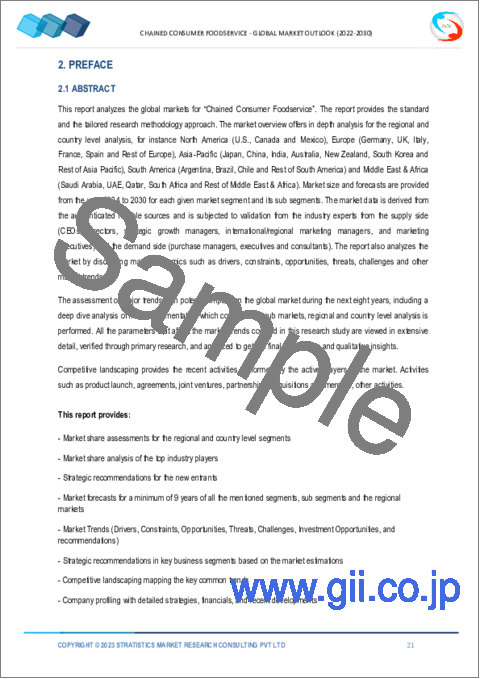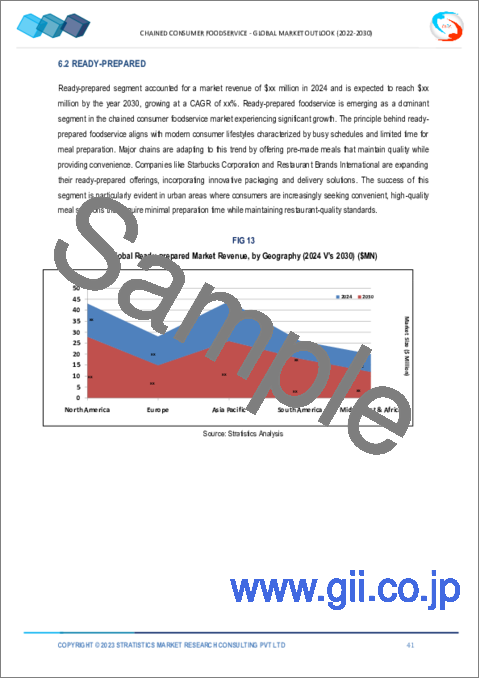|
|
市場調査レポート
商品コード
1454076
消費者向けフードサービスチェーン市場の2030年までの予測: タイプ別、サービスタイプ別、店舗タイプ別、立地別、用途別、地域別の世界分析Chained Consumer Foodservice Market Forecasts to 2030 - Global Analysis By Type (Franchise, Company-Owned and Hybrid Model), Service Type, Outlet Type, Location, Application and By Geography |
||||||
カスタマイズ可能
|
|||||||
| 消費者向けフードサービスチェーン市場の2030年までの予測: タイプ別、サービスタイプ別、店舗タイプ別、立地別、用途別、地域別の世界分析 |
|
出版日: 2024年03月03日
発行: Stratistics Market Research Consulting
ページ情報: 英文 200+ Pages
納期: 2~3営業日
|
全表示
- 概要
- 図表
- 目次
Stratistics MRCによると、消費者向けフードサービスチェーンの世界市場は2023年に9億2,860万米ドルを占め、2030年には13億7,790万米ドルに達すると予測されています。
チェーン化された消費者向け食品サービスとは、複数の店舗が単一のブランドまたは企業名の下で運営される食品サービスの一種であり、多くの場合、標準化された一連の手順、メニュー、ブランドに従っています。こうした店舗には、ファストフードチェーン、カジュアルダイニングチェーン、コーヒーショップチェーン、その他類似の店舗が含まれます。チェーン化された消費者向け食品サービス施設は、多くの場合、仕入れ、マーケティング、と運営におけるスケールメリットの恩恵を受けており、独立系の食品サービス事業と比較して、コスト効率と収益性の向上につながる可能性があります。また、ブランド認知という利点もあり、これによって顧客を引き付け、ロイヤルティを高めることができます。
都市化と多忙なライフスタイル
都市化が進むにつれて、社会人や共働き世帯が増加し、家庭で調理する時間が限られています。そのため、便利で手頃なメニューを求めて、チェーンレストランを利用する人が増えています。さらに、ペースの速いライフスタイルは、社交の場としての外食の傾向を強め、チェーン店にとって魅力的な雰囲気や体験を提供する機会を生み出し、チェーンレストランの需要をさらに高めています。
独立系レストランとの競合
独立系レストランは、市場支配に対する手ごわい課題となっています。独立系レストランの魅力は、ユニークな料理体験、一人ひとりに合わせたサービス、そしてしばしば地域社会との強いつながりを提供することにあります。こうしたレストランは、消費者の嗜好や動向の変化に迅速に対応することができ、チェーン店では太刀打ちできないような柔軟性と革新性を備えています。さらに、独立系レストランはしばしば、本物志向や職人的な質の高さを培い、画一的なチェーン店から利用者を引き離しています。
可処分所得の増加
消費者がより健康的なメニューや透明性の高い栄養情報を好むようになったことで、市場は健康志向へと大きくシフトしています。さらに、技術を活用してカスタマイズ・オプションを提供し、パーソナライズされたマーケティング・キャンペーンを展開することで、より健康的で社会的責任のある飲食体験を求める需要に応えています。
人件費の上昇と経営課題
市場は、人件費の高騰と運営上のハードルによるプレッシャーの高まりを経験しています。人件費が上昇する中、このセグメントの企業は収益性を維持する上で大きな課題に直面しています。このような状況では、消費者の需要や経済力学が進化する中で、これらの課題を緩和し、持続可能な成長を確保するために、業界内での戦略的適応とイノベーションが必要となります。
COVID-19の影響:
COVID-19の大流行はチェーンコンシューマーフードサービス市場に大きな影響を与え、広範な閉店、人通りの減少、デリバリーやテイクアウトサービスへのシフトを引き起こしました。外食産業は社会的距離を置く措置や衛生プロトコルにより経営上の課題に直面し、収益の減少や労働力の混乱につながった。衛生面や利便性が重視されるようになり、消費者の行動も変化しました。
予測期間中、フランチャイズセグメントが最大となる見込み
予測期間中、フランチャイズセグメントが最大となる見込みです。消費者が利便性と馴染みのブランドをますます好むようになる中、フランチャイズは競争の激しい外食産業への戦略的参入ポイントを提供します。フランチャイジーは、標準化されたプロセス、大量購買力、トレーニングプログラムなどを利用できるため、クイックサービスダイニング・オプションに対する需要の高まりに対応できるというメリットがあります。
予測期間中にCAGRが最も高くなると予想されるファーストフードセグメント
ファーストフードセグメントは予測期間中に最も高いCAGRが見込まれます。ハンバーガーやフライドポテトからサンドイッチやサラダまで幅広い選択肢を持つファストフードチェーンは、手頃な価格で効率的な食事体験を求める顧客を惹きつけています。健康や持続可能性への懸念にもかかわらず、これらの店舗は、その広範な存在感、積極的なマーケティング戦略、変化する消費者の嗜好や食事動向にメニューを適応させる能力により、繁栄を続けています。
最大のシェアを占める地域:
北米は、消費者の嗜好の進化とライフスタイルの変化に後押しされ、予測期間中最大の市場シェアを占めると予測されます。利便性と品質を重視するチェーンレストランや飲食店は、多様な嗜好や食事要件に対応するためにメニューを拡大しています。都市化、可処分所得の増加、各国料理への嗜好の高まりといった要因が、このセグメントの堅調な成長に寄与しています。
CAGRが最も高い地域:
予測期間中、アジア太平洋が最も高いCAGRを維持すると予測されます。多くの国々で急速な都市化が進み、ライフスタイルや食生活が変化しています。人々が都市に移住するにつれて、便利な食事の選択肢を求めることが多くなり、それがチェーン展開する外食店舗の拡大に拍車をかけています。多くの国の経済成長により可処分所得が増加し、定期的に外食をする消費者が増えています。
無料カスタマイズサービス:
本レポートをご購読のお客様には、以下の無料カスタマイズオプションのいずれかを差し上げます。
- 企業プロファイル
- 追加市場参入企業の包括的プロファイリング(3社まで)
- 主要企業のSWOT分析(3社まで)
- 地域セグメンテーション
- 顧客の関心に応じた主要国の市場推定・予測・CAGR(注:フィージビリティチェックによる)
- 競合ベンチマーキング
- 製品ポートフォリオ、地理的プレゼンス、戦略的提携に基づく主要企業のベンチマーキング
目次
第1章 エグゼクティブサマリー
第2章 序文
- 概要
- ステークホルダー
- 調査範囲
- 調査手法
- データ鉱業
- データ分析
- データ検証
- 調査アプローチ
- 調査ソース
- 1次調査ソース
- 2次調査ソース
- 前提条件
第3章 市場動向分析
- イントロダクション
- 促進要因
- 抑制要因
- 機会
- 脅威
- 用途分析
- 新興市場
- 新型コロナウイルス感染症(COVID-19)の影響
第4章 ポーターのファイブフォース分析
- 供給企業の交渉力
- 買い手の交渉力
- 代替品の脅威
- 新規参入業者の脅威
- 競争企業間の敵対関係
第5章 世界の消費者向けフードサービスチェーン市場:タイプ別
- イントロダクション
- フランチャイズ
- 法人所有
- ハイブリッドモデル
第6章 世界のチェーンコンシューマーフードサービス市場:サービスタイプ別
- イントロダクション
- レディプリペアド
- アセンブリ―
- 従来型
- サーブフードサービス
- 売店
第7章 世界の消費者向けフードサービスチェーン市場:アウトレットタイプ別
- イントロダクション
- カフェ/バー
- フルサービスのレストラン
- ファーストフード
- 露店
第8章 世界の消費者向けフードサービスチェーン市場:場所別
- イントロダクション
- 小売り
- レジャー
- スタンドアロン
- 旅行
- ホテル
第9章 世界の消費者向けフードサービスチェーン市場:用途別
- イントロダクション
- カジュアルダイニングチェーン
- コーヒーチェーン
- ピザチェーン
- サンドイッチチェーン
- ベーカリーチェーン
- その他
第10章 世界の消費者向けフードサービスチェーン市場:地域別
- イントロダクション
- 北米
- 米国
- カナダ
- メキシコ
- 欧州
- ドイツ
- 英国
- イタリア
- フランス
- スペイン
- その他の欧州
- アジア太平洋
- 日本
- 中国
- インド
- オーストラリア
- ニュージーランド
- 韓国
- その他のアジア太平洋
- 南米
- アルゼンチン
- ブラジル
- チリ
- その他の南米
- 中東・アフリカ
- サウジアラビア
- アラブ首長国連邦
- カタール
- 南アフリカ
- その他の中東・アフリカ
第11章 主要発展
- 契約、パートナーシップ、コラボレーション、合弁事業
- 買収と合併
- 新製品の発売
- 事業拡大
- その他の主要戦略
第12章 企業プロファイル
- McDonald's Corp.
- Aramark Corporation
- Dunkin'Brands Group PLC
- Papa Murphy's International LLC.
- Steven & I Holdings Co. Ltd.
- Chipotle Mexican Grill, Inc.
- Wendy's Co.
- Restaurant Brands International Inc.
- Domino's Pizza
- Compass Group PLC
- Panera Bread Company, Inc.
- Starbucks Corporation
- In-N-Out Burgers
- Darden Restaurants, Inc.
- Brinker International Inc.
- Yum!Brands, Inc.
List of Tables
- Table 1 Global Chained Consumer Foodservice Market Outlook, By Region (2021-2030) ($MN)
- Table 2 Global Chained Consumer Foodservice Market Outlook, By Type (2021-2030) ($MN)
- Table 3 Global Chained Consumer Foodservice Market Outlook, By Franchise (2021-2030) ($MN)
- Table 4 Global Chained Consumer Foodservice Market Outlook, By Company-Owned (2021-2030) ($MN)
- Table 5 Global Chained Consumer Foodservice Market Outlook, By Hybrid Model (2021-2030) ($MN)
- Table 6 Global Chained Consumer Foodservice Market Outlook, By Service Type (2021-2030) ($MN)
- Table 7 Global Chained Consumer Foodservice Market Outlook, By Ready-prepared (2021-2030) ($MN)
- Table 8 Global Chained Consumer Foodservice Market Outlook, By Assembly (2021-2030) ($MN)
- Table 9 Global Chained Consumer Foodservice Market Outlook, By Conventional (2021-2030) ($MN)
- Table 10 Global Chained Consumer Foodservice Market Outlook, By Serve Foodservice (2021-2030) ($MN)
- Table 11 Global Chained Consumer Foodservice Market Outlook, By Commissary (2021-2030) ($MN)
- Table 12 Global Chained Consumer Foodservice Market Outlook, By Outlet Type (2021-2030) ($MN)
- Table 13 Global Chained Consumer Foodservice Market Outlook, By Cafes/Bars (2021-2030) ($MN)
- Table 14 Global Chained Consumer Foodservice Market Outlook, By Full-Service Restaurants (2021-2030) ($MN)
- Table 15 Global Chained Consumer Foodservice Market Outlook, By Fast Food (2021-2030) ($MN)
- Table 16 Global Chained Consumer Foodservice Market Outlook, By Street Stalls (2021-2030) ($MN)
- Table 17 Global Chained Consumer Foodservice Market Outlook, By Location (2021-2030) ($MN)
- Table 18 Global Chained Consumer Foodservice Market Outlook, By Retail (2021-2030) ($MN)
- Table 19 Global Chained Consumer Foodservice Market Outlook, By Leisure (2021-2030) ($MN)
- Table 20 Global Chained Consumer Foodservice Market Outlook, By Standalone (2021-2030) ($MN)
- Table 21 Global Chained Consumer Foodservice Market Outlook, By Travel (2021-2030) ($MN)
- Table 22 Global Chained Consumer Foodservice Market Outlook, By Hotels (2021-2030) ($MN)
- Table 23 Global Chained Consumer Foodservice Market Outlook, By Application (2021-2030) ($MN)
- Table 24 Global Chained Consumer Foodservice Market Outlook, By Casual Dining Chains (2021-2030) ($MN)
- Table 25 Global Chained Consumer Foodservice Market Outlook, By Coffee Chains (2021-2030) ($MN)
- Table 26 Global Chained Consumer Foodservice Market Outlook, By Pizza Chains (2021-2030) ($MN)
- Table 27 Global Chained Consumer Foodservice Market Outlook, By Sandwich Chains (2021-2030) ($MN)
- Table 28 Global Chained Consumer Foodservice Market Outlook, By Bakery Chains (2021-2030) ($MN)
- Table 29 Global Chained Consumer Foodservice Market Outlook, By Other Applications (2021-2030) ($MN)
Note: Tables for North America, Europe, APAC, South America, and Middle East & Africa Regions are also represented in the same manner as above.
According to Stratistics MRC, the Global Chained Consumer Foodservice Market is accounted for $928.6 million in 2023 and is expected to reach $1,377.9 million by 2030 growing at a CAGR of 5.8% during the forecast period. Chained consumer foodservice refers to a type of foodservice operation where multiple outlets are operated under a single brand or company name, often following a standardized set of procedures, menus, and branding. These outlets can include fast food chains, casual dining chains, coffee shop chains, and other similar establishments. Chained consumer foodservice establishments often benefit from economies of scale in purchasing, marketing, and operations, which can lead to cost efficiencies and greater profitability compared to independent foodservice operations. They also have the advantage of brand recognition, which can help attract customers and build loyalty.
Market Dynamics:
Driver:
Urbanization and busy lifestyles
The increasing urbanization has led to a rise in the number of working professionals and dual-income households, resulting in limited time for cooking at home. This has driven individuals to turn to chain restaurants for their dining needs, seeking convenient and affordable options. Additionally, the fast-paced lifestyle has led to the growing trend of eating out as a social activity, creating opportunities for chains to provide attractive ambiance and experiences, further bolstering the demand for chain restaurants.
Restraint:
Competition from independent restaurants
Independent restaurants present a formidable challenge to the dominance of markets. Their appeal lies in offering unique culinary experiences, personalized service, and often, a strong connection to local communities. These establishments can adapt swiftly to changing consumer tastes and trends, providing a level of flexibility and innovation that chains struggle to match. Moreover, independent restaurants often cultivate a sense of authenticity and artisanal quality, drawing patrons away from standardized chain offerings.
Opportunity:
Growing disposable income
The market is experiencing a significant shift towards health and wellness, driven by consumers increasing preference for healthier options and transparent nutritional information. Additionally, technology is being leveraged to offer customization options and create personalized marketing campaigns, catering to the demand for healthier and more socially responsible dining experiences.
Threat:
Rising labour costs and operational challenges
The market is experiencing mounting pressures due to escalating labor costs and operational hurdles. With labour expenses on the rise, businesses within the sector are facing significant challenges in maintaining profitability. Such circumstances necessitate strategic adaptation and innovation within the industry to mitigate these challenges and ensure sustainable growth amidst the evolving landscape of consumer demands and economic dynamics.
Covid-19 Impact:
The COVID-19 pandemic significantly impacted the Chained Consumer Foodservice Market, causing widespread closures, reduced foot traffic, and shifts towards delivery and takeout services. Restaurants faced operational challenges due to social distancing measures and health protocols, leading to decreased revenues and workforce disruptions. Consumer behavior changed with a heightened emphasis on hygiene and convenience, prompting establishments to adapt their offerings and business models.
The franchise segment is expected to be the largest during the forecast period
The franchise segment is expected to be the largest during the forecast period. With consumers increasingly favouring convenience and familiar brands, franchising provides a strategic entry point into the competitive foodservice industry. Franchisees benefit from access to standardized processes, bulk purchasing power, and training programs, enabling them to capitalize on the growing demand for quick-service dining options.
The fast food segment is expected to have the highest CAGR during the forecast period
The fast food segment is expected to have the highest CAGR during the forecast period. With a wide array of options ranging from burgers and fries to sandwiches and salads, fast food chains attract customers seeking affordable and efficient dining experiences. Despite concerns about health and sustainability, these establishments continue to thrive due to their widespread presence, aggressive marketing strategies, and ability to adapt menus to changing consumer preferences and dietary trends.
Region with largest share:
North America is projected to hold the largest market share during the forecast period propelled by evolving consumer preferences and lifestyle changes. With an emphasis on convenience and quality, chain restaurants and eateries have expanded their offerings to cater to diverse tastes and dietary requirements. Factors such as urbanization, increasing disposable income, and a growing appetite for international cuisines contribute to the sector's robust growth.
Region with highest CAGR:
Asia Pacific is projected to hold the highest CAGR over the forecast period. Rapid urbanization across many countries has led to changing lifestyles and dietary habits. As people migrate to cities, they often seek out convenient dining options, which have fueled the expansion of chained foodservice outlets. Economic growth in many countries has resulted in rising disposable incomes, enabling more consumers to dine out regularly.
Key players in the market
Some of the key players in Chained Consumer Foodservice market include McDonald's Corp., Aramark Corporation, Dunkin' Brands Group PLC, Papa Murphy's International LLC., Steven & I Holdings Co. Ltd., Chipotle Mexican Grill, Inc., Wendy's Co., Restaurant Brands International Inc., Domino's Pizza, Compass Group PLC, Panera Bread Company, Inc., Starbucks Corporation, In-N-Out Burgers, Darden Restaurants, Inc., Brinker International Inc. and Yum! Brands, Inc.
Key Developments:
In January 2024, Domino's Pizza announced that with the integration with ONDC, Domino's catalogues will be seen on multiple apps from across the network for seamless transactions, the pizza chain said.
In December 2023, McDonald's Corporation announced ambitious new growth targets to advance its Accelerating the Arches strategy. McDonald's aims to expand its loyalty program from 150 million to 250 million 90-day active users by 2027.
Types Covered:
- Franchise
- Company-Owned
- Hybrid Model
Service Types Covered:
- Ready-prepared
- Assembly
- Conventional
- Serve Foodservice
- Commissary
Outlet Types Covered:
- Cafes/Bars
- Full-Service Restaurants
- Fast Food
- Street Stalls
Locations Covered:
- Retail
- Leisure
- Standalone
- Travel
- Hotels
Applications Covered:
- Casual Dining Chains
- Coffee Chains
- Pizza Chains
- Sandwich Chains
- Bakery Chains
- Other Applications
Regions Covered:
- North America
- US
- Canada
- Mexico
- Europe
- Germany
- UK
- Italy
- France
- Spain
- Rest of Europe
- Asia Pacific
- Japan
- China
- India
- Australia
- New Zealand
- South Korea
- Rest of Asia Pacific
- South America
- Argentina
- Brazil
- Chile
- Rest of South America
- Middle East & Africa
- Saudi Arabia
- UAE
- Qatar
- South Africa
- Rest of Middle East & Africa
What our report offers:
- Market share assessments for the regional and country-level segments
- Strategic recommendations for the new entrants
- Covers Market data for the years 2021, 2022, 2023, 2026, and 2030
- Market Trends (Drivers, Constraints, Opportunities, Threats, Challenges, Investment Opportunities, and recommendations)
- Strategic recommendations in key business segments based on the market estimations
- Competitive landscaping mapping the key common trends
- Company profiling with detailed strategies, financials, and recent developments
- Supply chain trends mapping the latest technological advancements
Free Customization Offerings:
All the customers of this report will be entitled to receive one of the following free customization options:
- Company Profiling
- Comprehensive profiling of additional market players (up to 3)
- SWOT Analysis of key players (up to 3)
- Regional Segmentation
- Market estimations, Forecasts and CAGR of any prominent country as per the client's interest (Note: Depends on feasibility check)
- Competitive Benchmarking
- Benchmarking of key players based on product portfolio, geographical presence, and strategic alliances
Table of Contents
1 Executive Summary
2 Preface
- 2.1 Abstract
- 2.2 Stake Holders
- 2.3 Research Scope
- 2.4 Research Methodology
- 2.4.1 Data Mining
- 2.4.2 Data Analysis
- 2.4.3 Data Validation
- 2.4.4 Research Approach
- 2.5 Research Sources
- 2.5.1 Primary Research Sources
- 2.5.2 Secondary Research Sources
- 2.5.3 Assumptions
3 Market Trend Analysis
- 3.1 Introduction
- 3.2 Drivers
- 3.3 Restraints
- 3.4 Opportunities
- 3.5 Threats
- 3.6 Application Analysis
- 3.7 Emerging Markets
- 3.8 Impact of Covid-19
4 Porters Five Force Analysis
- 4.1 Bargaining power of suppliers
- 4.2 Bargaining power of buyers
- 4.3 Threat of substitutes
- 4.4 Threat of new entrants
- 4.5 Competitive rivalry
5 Global Chained Consumer Foodservice Market, By Type
- 5.1 Introduction
- 5.2 Franchise
- 5.3 Company-Owned
- 5.4 Hybrid Model
6 Global Chained Consumer Foodservice Market, By Service Type
- 6.1 Introduction
- 6.2 Ready-prepared
- 6.3 Assembly
- 6.4 Conventional
- 6.5 Serve Foodservice
- 6.6 Commissary
7 Global Chained Consumer Foodservice Market, By Outlet Type
- 7.1 Introduction
- 7.2 Cafes/Bars
- 7.3 Full-Service Restaurants
- 7.4 Fast Food
- 7.5 Street Stalls
8 Global Chained Consumer Foodservice Market, By Location
- 8.1 Introduction
- 8.2 Retail
- 8.3 Leisure
- 8.4 Standalone
- 8.5 Travel
- 8.6 Hotels
9 Global Chained Consumer Foodservice Market, By Application
- 9.1 Introduction
- 9.2 Casual Dining Chains
- 9.3 Coffee Chains
- 9.4 Pizza Chains
- 9.5 Sandwich Chains
- 9.6 Bakery Chains
- 9.7 Other Applications
10 Global Chained Consumer Foodservice Market, By Geography
- 10.1 Introduction
- 10.2 North America
- 10.2.1 US
- 10.2.2 Canada
- 10.2.3 Mexico
- 10.3 Europe
- 10.3.1 Germany
- 10.3.2 UK
- 10.3.3 Italy
- 10.3.4 France
- 10.3.5 Spain
- 10.3.6 Rest of Europe
- 10.4 Asia Pacific
- 10.4.1 Japan
- 10.4.2 China
- 10.4.3 India
- 10.4.4 Australia
- 10.4.5 New Zealand
- 10.4.6 South Korea
- 10.4.7 Rest of Asia Pacific
- 10.5 South America
- 10.5.1 Argentina
- 10.5.2 Brazil
- 10.5.3 Chile
- 10.5.4 Rest of South America
- 10.6 Middle East & Africa
- 10.6.1 Saudi Arabia
- 10.6.2 UAE
- 10.6.3 Qatar
- 10.6.4 South Africa
- 10.6.5 Rest of Middle East & Africa
11 Key Developments
- 11.1 Agreements, Partnerships, Collaborations and Joint Ventures
- 11.2 Acquisitions & Mergers
- 11.3 New Product Launch
- 11.4 Expansions
- 11.5 Other Key Strategies
12 Company Profiling
- 12.1 McDonald's Corp.
- 12.2 Aramark Corporation
- 12.3 Dunkin' Brands Group PLC
- 12.4 Papa Murphy's International LLC.
- 12.5 Steven & I Holdings Co. Ltd.
- 12.6 Chipotle Mexican Grill, Inc.
- 12.7 Wendy's Co.
- 12.8 Restaurant Brands International Inc.
- 12.9 Domino's Pizza
- 12.10 Compass Group PLC
- 12.11 Panera Bread Company, Inc.
- 12.12 Starbucks Corporation
- 12.13 In-N-Out Burgers
- 12.14 Darden Restaurants, Inc.
- 12.15 Brinker International Inc.
- 12.16 Yum! Brands, Inc.





